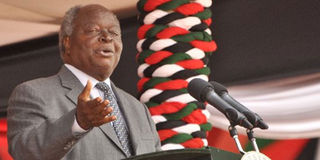Kibaki's last chance to shape economy

Photo|FILE
The Kibaki administration will be best remembered for projects especially in infrastructural development and phenomenal growth in ICT, but also for failing to close the gap between the rich and poor.
The Budget Speech to be delivered in Parliament on Thursday will bear special significance for President Kibaki.
It will not just be the last Budget during his 10 years as President, but it will also mark the final opportunity to reshape the economic landscape for a President, who rode to office touting his credentials as an economist and successful Finance minister.
President Kibaki served at the Treasury for a lengthy era from 1970 to 1978 — a period when the country enjoyed steady economic growth that earned him plaudits locally and internationally.
His campaign for the presidency was based largely on his promise to reverse the economic decline witnessed under the Moi regime and put the country back on the path of robust growth, prosperity and sound financial management.
Therefore, the last Budget under his two terms to be read on Thursday by new Finance Minister Njeru Githae, will also serve as a reflection on Kibakinomics.
A free economy marks the socio-economic legacy of the Kibaki administration, but opinion remains divided on his accomplishments.
“I think what he has done is to relatively strengthen institutions by giving them space to implement policies. The next President should build on this and put more emphasis on fighting corruption and streamlining the Judiciary,” University of Nairobi economist Joy Kiilu says.
The Kibaki administration will be best remembered for projects especially in infrastructural development and phenomenal growth in ICT, but also for failing to close the gap between the rich and poor.
To his credit, the development allocation has grown steadily, especially in roads and energy, setting a good foundation for future growth.
His landmark legacy remains the pro-poor free primary education launched in 2003 that allowed hundreds of thousands of under-privileged children to access school for the first time.
“One thing that stands out in the whole of his time is the free primary education. His administration has been able to refine it and make it work better, thus giving a good start to the working population,” Nairobi economist Robert Shaw says.
Clinton’s praise
Free primary and secondary education earned the President the admiration of former US president Bill Clinton, who on learning that Kenya had been able to put over one million children in school, noted that the one man in the world he would like to meet was President Kibaki.
When the FPE was rolled out, an estimated 1.5 million children enrolled in various stages of education.
Critics, however, fault the programme for failing to put resources towards improving the quality of education by hiring adequate teachers and building new schools to ease crowding.
Other critics argue that FPE does not help the very poor. In a report done by HakiJamii titled: ‘Kenya’s budget allocation patterns for basic education in urban slums’, the NGO says that while three-quarters of families living in low-income formal settlement benefit from the free basic education, only half of those living in the slums take their children to public schools.
In the 2002 Budget, the last under the Moi regime, roads and energy received a mere 6.5 per cent of the total budget allocation.
This year, the Kibaki administration, having identified infrastructure as the engine of growth, allocated 20 per cent of the total budget to roads and energy development — five percentage points more than the previous government allocated overall in development expenditure.
“Decent road network throughout the country is crucial for growth, investment, employment creation and poverty reduction,” read Deputy Prime Minister Uhuru Kenyatta in last year’s Budget Speech.
In his first year, President Kibaki presented the country with a budget outlay of Sh393.6 billion. This has grown three-fold over the past 10 years to Sh1.4 trillion. The growth has been largely attributed to improved tax collection and growth in the country’s wealth.
In one of its Budget analysis papers, audit firm PricewaterhouseCoopers says that policy measures by the Kibaki administration have aligned to “address priorities shared by the government and private sector but they may not be sufficient to achieve strong long-term economic growth, a skilled workforce and other pillars of Vision 2030.”
In its pursuit of infrastructure development, the government increased borrowing, which, by last year, had hit a worrying 56 per cent debt-GDP ratio — way above the global sustainable ratio of 42 per cent.
However, the Kibaki government has gone out of its way to appease the youth, who constitute 35.4 per cent of the population, setting up both the Youth Enterprise Fund and the Women Enterprise Fund. It also enhanced the Kenya Youth Empowerment Programme setting aside Sh1.6 billion in the scandal-ridden Kazi Kwa Vijana programme.
However, many of these pro-poor and employment creation programmes have failed. “What remains to be seen is a demonstration by the fund managers that the objectives for which these funds were set up have been achieved,” PricewaterhouseCoopers noted last June.
According to the Institute of Economic Affairs, the failure has been more in the lack of a clear implementation mechanism in spending and absorbing funds allocated to new projects.
It is this trend that saw analysts described the 2011/12 Budget as one steeped in good intentions but short of implementation details.



